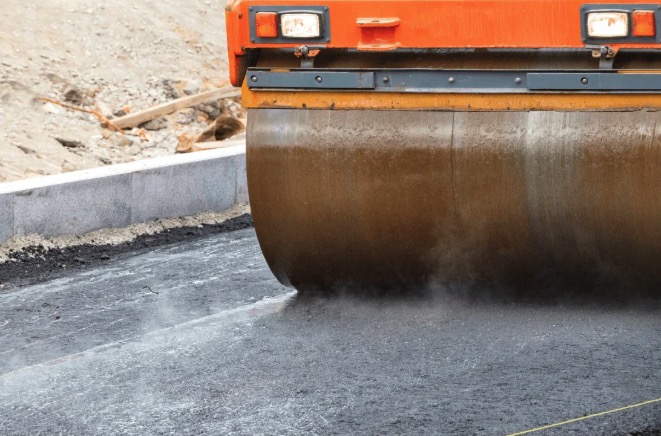
— November 03, 2025
If you’ve driven on a highway while it’s under construction, then chances are you’ve seen a road roller in action. In its most basic form, a road roller is a heavy piece of equipment consisting of a cylindrical drum that rolls in front of or behind the machine, compacting and flattening the surface as it moves along.
A road roller is used for compacting and leveling surfaces like roads, pavements and soil. Road rollers are typically fitted with heavy, large drums made of steel, which roll over the work surface and compress the material while smoothing out irregularities.
Road rollers have a variety of applications, but they are generally used to compact loose soil, asphalt, concrete and other base surfaces. They’re widely used in preparing and strengthening foundations, road construction and agriculture.
Road rollers come in a variety of types and sizes. Each type of road roller is suited to a particular use case or base material/terrain.
Smooth wheeled, or static, rollers are the most common type of road roller. They have a heavy cylindrical steel drum that is totally smooth/flat on its surface. Static rollers are used for compacting large, flat areas such as parking lots, highways and industrial sites.
Single drum rollers consist of a steel drum and a set of tires. Usually, the steel drum sits at the front of the machine, while the tires are situated at the machine’s rear. Since only one side of the machine is fitted with a roller, the machine can only be operated in a single direction and is less efficient than a double drum roller.
Double drum rollers consist of two steel drums – one at the front and another at the rear of the machine. Since both ends of the machine have a roller, they are more efficient than single drum rollers and can be operated in either direction. Since they don’t have tires, they don’t have as much traction as single drum rollers and cannot be used on steep slopes.
Trench rollers have a compact frame and are designed to be used in narrow work spaces, like trenches. They are ideal for compacting soil, sand and other materials in utility trenches or underground work surfaces.
Vibratory rollers, as their name suggests, are rollers with a drum that vibrates as it rolls along the work surface. Vibratory rollers can provide similar performance as much larger rollers while maintaining a more compact form factor, since the vibrating action greatly increases their efficiency. They are ideal for use in road and foundation construction where a high degree of compaction is necessary.
Pneumatic rollers look unique because, rather than a steel drum, they use a series of smooth, rubber tires filled with air or water to compact the work surface. They are used in applications where a flat, even surface is required, such as parking lots or airport runways. Since they use rubberized tires in place of a steel drum, pneumatic rollers can be fine-tuned to deliver more precise levels of compaction.
Unlike other types of rollers, sheepsfoot rollers do not have a smooth drum. Rather, the roller on a sheepsfoot roller has pads, or feet, that protrude from the surface of the roller in a checkered pattern. These feet make the roller better equipped for compacting rough and uneven surfaces, such as clumped soil. They’re frequently used in agriculture for smoothing fields after plowing.
Grid rollers have a steel drum that is not flat, but is made up of steel bars arranged in a checkered pattern. This type of roller is typically a pulling unit, and gets pulled behind a truck or another heavy equipment vehicle. The unique design of the drum makes this type of roller best suited for working on coarse soil and for subgrade road construction projects.
Compared to common heavy equipment, such as excavators and skid steers, drum rollers aren’t as versatile and get used on fewer projects. This is because, while other heavy equipment has a wide range of uses, drum rollers are used exclusively for compacting and flattening surfaces.

Road rollers typically feature water lubrication systems that spray water onto the work surface as the machine rolls along. By lubricating the work surface with water, the energy required to compact the surface is reduced greatly, improving the machine’s efficiency. Not only does water lubrication improve the machine’s ability to compact the work surface, but it also reduces wear on the drum and prevents damage to the surface being compacted.
A road roller’s water lubrication system consists of a few key components:
Most road rollers run on diesel engines, which are known for being reliable and having a high torque output. Hydraulic transmissions are also common in road rollers, since they can provide precise control over the speed and torque of the roller.
In most road rollers, a diesel engine powers the machine and supplies power to a hydraulic pump. The hydraulic pump forces hydraulic fluid through a series of valves and hoses to a hydraulic motor, which then drives the wheels or drum.
Like other heavy equipment, road rollers need to be properly maintained in order to maximize their efficiency and lifespan. The best way to maintain your road roller is through the implementation of a preventative maintenance plan.
Here are some key areas to consider for your road roller’s preventative maintenance plan:
Maintain the hydraulic system – If your machine has a hydraulic transmission, then you’ll need to make sure the hydraulic fluid and filter are maintained. Check the components of your machine’s hydraulic system regularly and replace them according to the intervals in the machine’s service manual.
Properly maintaining the quality of your road roller is necessary to ensure it has a long lifespan. If you’re in need of a new part for your roller or other machine, visit MechLink’s online parts catalog to find high-quality OEM and aftermarket components. Still can’t find what you need? Reach out to one of our parts experts for personalized assistance.

Key components of heavy equipment undercarriage maintenance
December 19, 2025

How to change the hydraulic filter in your heavy equipment and why it matters
December 19, 2025

The best equipment for snow removal: heavy machinery to use this winter
December 18, 2025

How to prevent rust and corrosion on heavy construction equipment
December 18, 2025